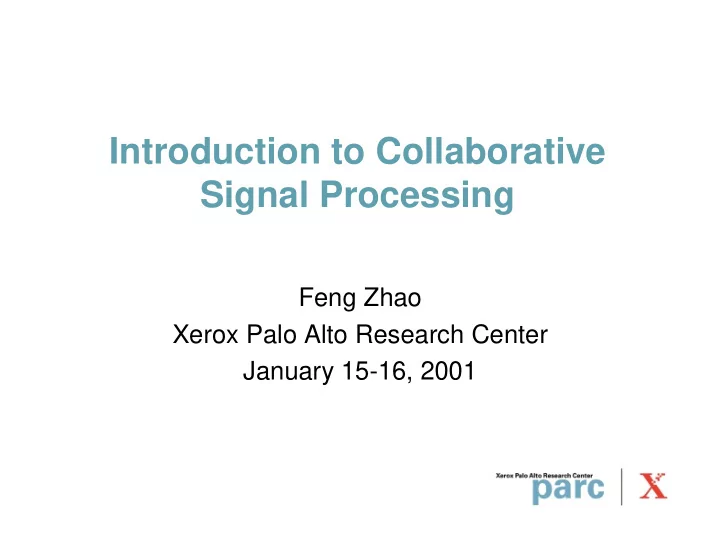

Introduction to Collaborative Signal Processing Feng Zhao Xerox Palo Alto Research Center January 15-16, 2001
29 Palms, August 2000
Model-Directed Sensing and Estimation Insight: Model provides spatio- temporal priors to focus sensing and signal processing! Models Features Aggregation Sensor fusion Parameter estimation Signals and Event components sensing Source Separation Event Event Event
Tracking job flow in a printshop • The problem : Identify workflow of printshops consisting of multiple machines – Determine job initiation, duration, and component conditions – Optimize the shop operations using the information • Requirement: Minimal disruption to existing printshop operation and intrusion to customer networks (security) • Approach: Use distributed microphones and RF tags to locate/track job flows RF tag reader Media Printing Printing Storage Wireless link Printshop Collating Plate Internet Printing connection PC Microphones Binding Shipment Preparation (boxing) Shipping and Receiving
Idea: Event model as a temporal prior in distributed monitoring 0.11 • As in speech processing, identify Estimated time 0.1 predicted time grammar and inter-word constraints 0.09 posterior 0.08 • Use a Petri net event model to 0.07 0.06 constrain the search for next “word” 0.05 0.04 -5 -4 -3 -2 -1 0 1 2 3 4 5 time deviation [ms] − − = 1 2 t t t ( ) ( , , ) (1) Prediction : P e M e e L (2) Source separation : 0.06 AS pull-in t t α δ − τ α δ − τ Unknown ( ) L ( ) z t t s acoustic signature 0.04 1 11 11 1 m 1 m 1 = ∗ AS off M M M α δ − τ α δ − τ ( ) L ( ) t t t t z n 1 n 1 nm nm s 0.02 n m Likelihood function : [ ] 0 α τ = ⋅ t − 1 ( | , ) exp P k t T 1 t − Σ z ( ) r r 1 -0.02 2 = ⋅ ⋅ t t t t t (3) Update : ( | ) ( | ) ( ) P e k P e P e z z -0.04 2 FM off FM ramp-up stack elevation Unknown -0.06 0 0.1 0.2 0.3 0.4 0.5 0.6 0.7 0.8 0.9 1 time [s] Multi-channel data streams
Dynamics as a prior in multiple target tracking Particle Filter (Condensation) as an implementation for Bayesian Filtering • Multi-modal, non-Gaussian distribution • Uniform representation Probability ( | ) P S Z − − 1 1 k k distribution at k-1 Prediction ( | ) P S k S − 1 k Observation ( | ) P Z k S k Probability ( | ) P S k Z k distribution at k Two vehicle targets cross over
A few issues in distributed implementation • Distribute hypotheses and models • Transmit results v.s. raw data • Exchange and combine data with great variability in latency and quality • Dense small nodes vs. sparse large nodes • Track pixels v.s. predicates • Sensor wakeup and cueing • Taxonomy of application scenarios
Emerging Discipline Sensor Fusion & Adaptive Decision Theory Systems Collaborative Collaborative Signal Signal Processing Processing Space-time Distributed Signal Algorithms Processing Low-Power Computation & Communication
Recommend
More recommend